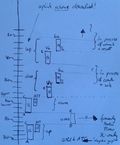 In my post yesterday I've been wondering if there are large wastelands of duplex gaps hanging around in the US 700 MHz band that is currently used only by AT&T and Verizon for 10 MHz LTE channels. I received two very good responses that made it clear that the duplex gaps I was seeing are actually not there at all. Instead what I was observing is a combination so far unused spectrum, unauctioned spectrum, overlapping bands and unidirectional spectrum that has been sold between the players recently. The situation is best described with a little diagram that I drew up on a napkin and shown on the left. Also have a look at the diagrams in this post which are more precise but have less information in them.
In my post yesterday I've been wondering if there are large wastelands of duplex gaps hanging around in the US 700 MHz band that is currently used only by AT&T and Verizon for 10 MHz LTE channels. I received two very good responses that made it clear that the duplex gaps I was seeing are actually not there at all. Instead what I was observing is a combination so far unused spectrum, unauctioned spectrum, overlapping bands and unidirectional spectrum that has been sold between the players recently. The situation is best described with a little diagram that I drew up on a napkin and shown on the left. Also have a look at the diagrams in this post which are more precise but have less information in them.
On the vertical axis I've drawn the 700 MHz frequency band in 5 MHz increments. There's the lower 700 MHz band and the upper 7000 MHz band separated by the dotted line about one third up in the diagram. The lower 700 MHz band is currently used by AT&T for a 10 MHz LTE channel in what is called the 3GPP Band 17 or B+C block in FCC speak. Band 17 is a subset of band 12 which is 2×15 MHz (note: the scale of band 12 and 17 in my drawing is not quite accurate, 17 should be 2/3 the size of band 12 but is drawn a bit smaller). The reason for the sub-banding is quite interesting and described in more detail in this post which I was pointed in one of the comments to my post yesterday.
The 10 MHz duplex gap in the lower 700 MHz band is the FCC D+E block and was bought by Qualcomm for their MediaFlow streaming services. The service never saw the light of day and in the meantime, Qualcomm has sold the 10 MHz patch to AT&T who plans to use the spectrum one day for LTE with LTE-Advanced Carrier bundling. That leaves me wondering a bit of how much of this spectrum will be usable as I suppose at least some gap is required between the uplink and the extended downlink. But AT&T paid close to two billion dollars for it so I guess they knew what they were doing.
The upper 700 MHz band is currently used by Verizon with a 10 MHz LTE carrier in what is called band 13 (The FCC upper C block). The gap between downlink and uplink contains band 14 which nobody wanted during the last spectrum auction and some additional spectrum that was never on the auction block at all. Also interesting in the drawing is that in the upper 700 MHz band, uplink and downlink are reversed from how it is usually done. This was done, from what I read between the lines to have band 17 and band 13 downlinks together to prevent interference between up and downlink of bands 17 (AT&T) and band 13 (Verizon).
To summarize: Yes, the large gaps I've been observing are there but they are not really unused duplex gaps but rather unused spectrum that might one day be taken into good use once AT&T figures out how to use Qualcomm's ex-Media Flow duplex gap spectrum in the lower band and once band 14 spectrum in the upper 700 band is sold.